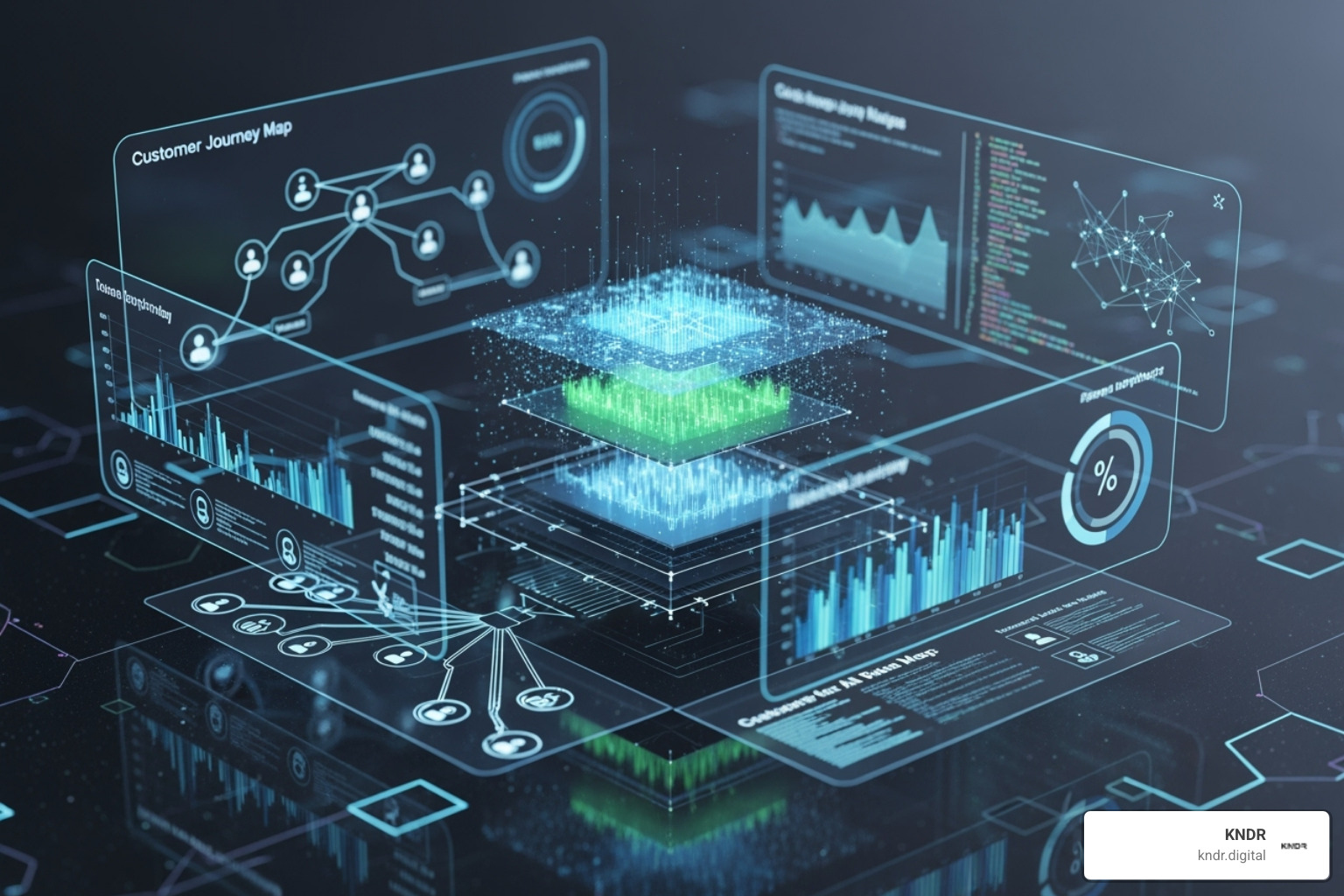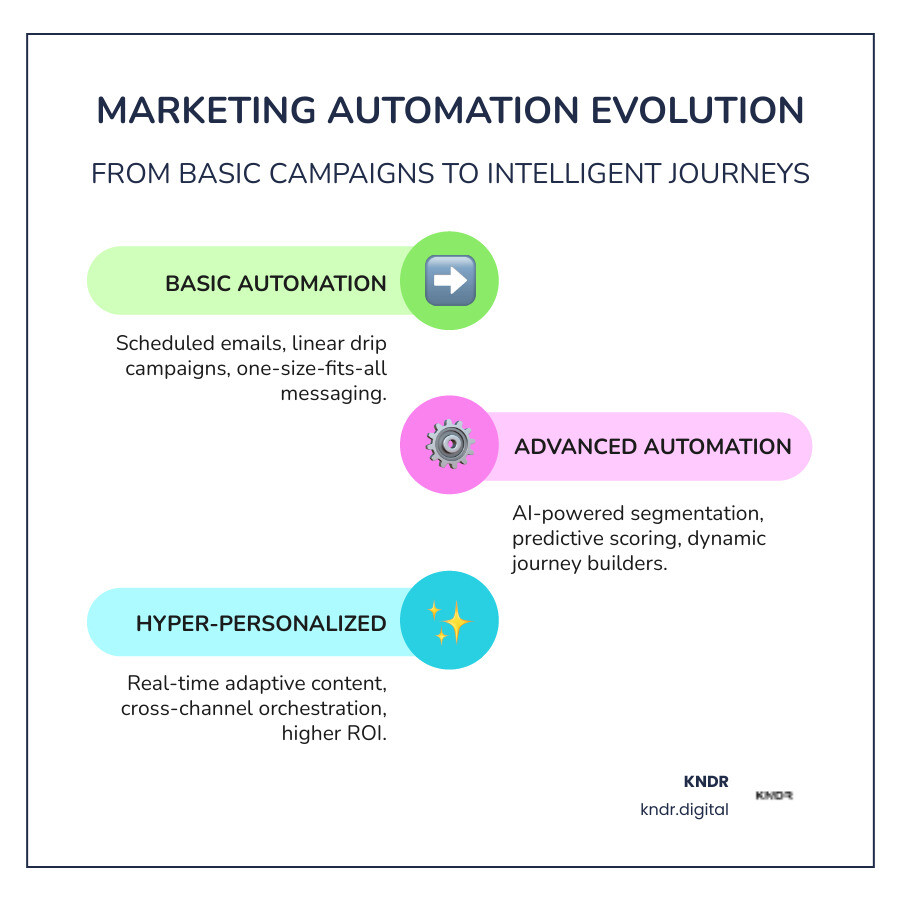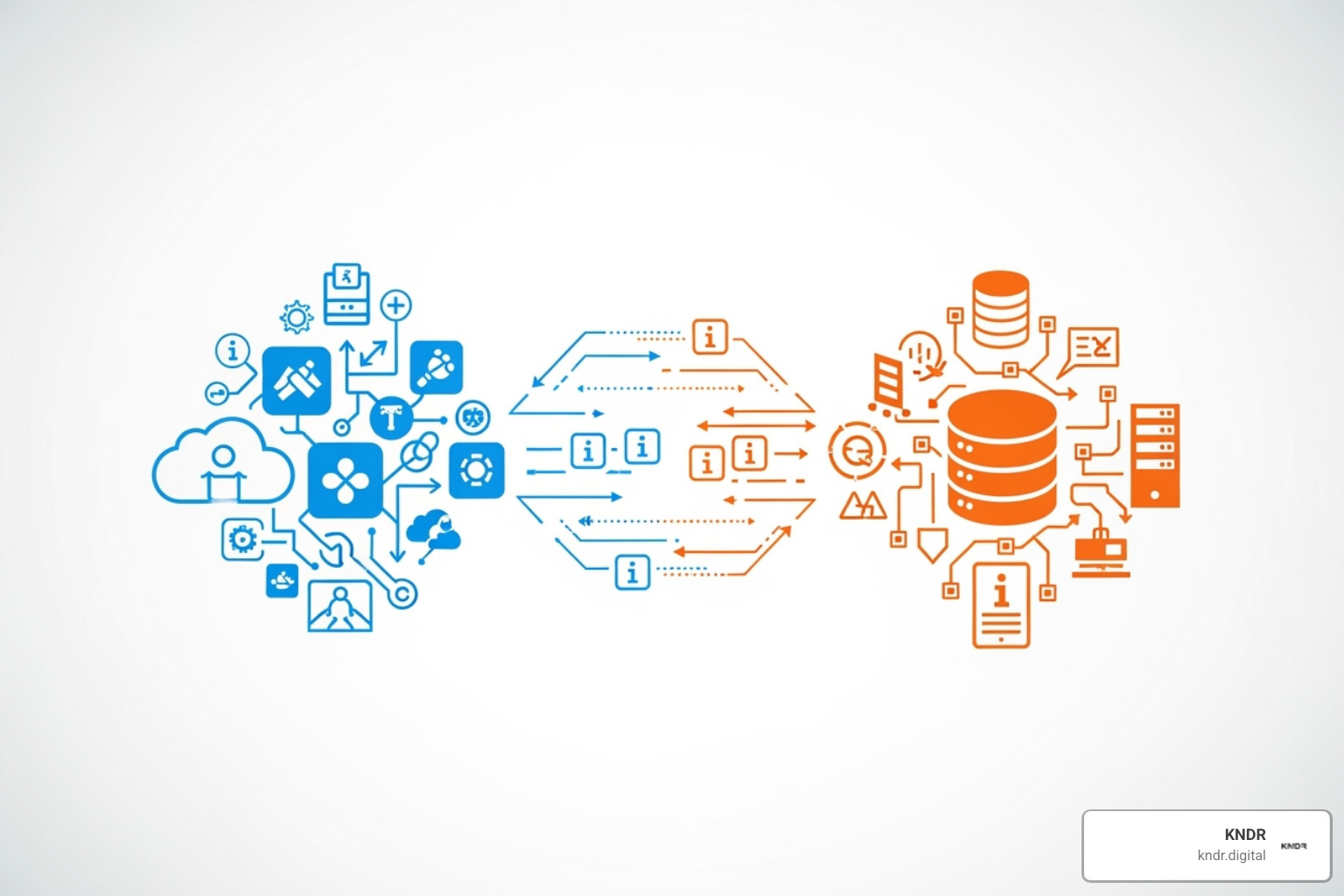Automate Like a Pro: The Next Frontier in Marketing

Why Advanced Marketing Automation is the Future of Nonprofit Growth
Advanced marketing automation is more than just scheduled emails. It's an intelligent system using AI, predictive analytics, and dynamic workflows to create personalized donor journeys that adapt in real-time to supporter behavior.
Key components include AI-powered segmentation, predictive lead scoring, dynamic journey builders, cross-channel orchestration, real-time personalization, and deep CRM integration. The shift from basic to advanced automation is dramatic. Instead of sending one generic welcome email, advanced marketing automation creates unique paths for each donor. A first-time small donor might receive educational content, while a returning supporter gets updates on programs they've previously funded.
The results are compelling. Organizations using advanced automation see email click-through rates increase by 12.1%, cart recovery rates jump to 15.1%, and some achieve 72x ROI within 12 months. One company even reduced its sales cycle by 20% through automated lead scoring.
As Mahir Iskender, CEO of KNDR.digital, I've helped dozens of nonprofits transform their fundraising through advanced marketing automation strategies that combine AI-powered donor insights with personalized engagement workflows. My experience building performance-based growth systems has shown me how the right automation can turn struggling organizations into fundraising powerhouses.

The Core Components of Advanced Marketing Automation
Think of advanced marketing automation as a solid foundation for a house, with essential components working together. This section breaks down the technologies that power a truly intelligent and responsive marketing engine.
AI and Predictive Analytics
At the heart of advanced marketing automation lies Artificial Intelligence and predictive analytics. These tools transform donor data into smart, automated actions. Predictive lead scoring uses AI to analyze donor behavior and engagement, automatically scoring each prospect to prioritize your fundraising team's efforts. AI-powered segmentation identifies complex behavioral patterns, allowing for highly targeted campaigns. For example, it might find that donors who read your newsletter on Tuesday mornings are 3x more likely to give to a specific program.
AI also enables send-time optimization, scheduling messages for when each individual is most likely to open them. Content personalization adapts your website and emails in real-time based on a donor's interests, while churn prediction acts as an early warning system to identify supporters who may be drifting away. For more on this, see our guide on AI-Driven Fundraising Insights.
Dynamic Customer Journey Builders
Dynamic journey builders create personalized paths that adapt to every action a supporter takes, much like a choose-your-own-trip story.

The magic is in if/then/else logic. If a donor opens an email, they get a specific follow-up; if they click a donation button, they're routed to a thank-you series. This ensures every donor has a unique experience. Multi-channel orchestration extends these journeys across email, text, and web for a seamless experience. Behavioral triggers make automation responsive, launching follow-ups for actions like visiting a donation page without giving. With A/B testing paths, you can continuously test and refine your strategy for maximum impact, while lead nurturing flows guide prospects from first contact to committed donor.
Sophisticated Segmentation and Personalization
Today's donors expect personalized communication. Advanced marketing automation makes this possible at scale. Dynamic lists automatically update donor segments based on real-time behavior, so your lists are always accurate. Behavioral segmentation creates precise groups based on interactions, such as "newsletter readers who never donate" or "event attendees who give annually."
While demographic data provides a foundation, automation enriches it with behavioral insights from website interaction tracking. You see which pages donors visit and what content they download, allowing for real-time personalization that adapts your website and emails to their interests. For more, explore our Guide to AI-Powered Donor Segmentation.
The Critical Role of CRM Integration
Your Customer Relationship Management (CRM) system is your organization's memory center. When seamlessly connected with advanced marketing automation, the real magic happens.

A 360-degree customer view combines all donor information—marketing interactions, development notes, event attendance—into one complete picture. This fosters sales and marketing alignment, creating a cycle where marketing provides warm leads and development updates feed back into stewardship campaigns. Data synchronization keeps everything current across both platforms automatically. The lead handoff process ensures high-scoring prospects are assigned to the right team member quickly. Finally, closed-loop reporting connects every dot from first visit to major gift, proving marketing's impact and guiding future strategy. For more on this, explore our insights on Donor Management Best Practices.
Putting Advanced Automation into Action: From Leads to Loyalty
Now that we understand the components, let's explore how to apply advanced marketing automation across the donor lifecycle to generate, nurture, and convert leads while building lasting loyalty.
Supercharging Lead Generation and Scoring
Advanced marketing automation helps you acquire new supporters with precision. Progressive profiling avoids overwhelming new visitors with long forms by asking for information incrementally over several visits. Gated content, like a valuable guide or webinar, works as an effective lead magnet in exchange for contact information.
Automated lead assignment is a breakthrough. When a potential major donor downloads a report, the system can instantly assign them to a development officer for follow-up, ensuring no hot leads go cold. Multi-touch attribution reveals the full journey a donor takes, from a Google search to their first donation, giving credit to all touchpoints. AI predictive lead scoring analyzes thousands of interactions to predict which leads are most likely to become major donors, while website visitor tracking provides insights into their specific interests. For more, see our automated donation system strategies.
Nurturing Leads with Hyper-Personalized Content
Lead nurturing is about building a meaningful, consistent relationship. Advanced marketing automation makes this possible at scale.

Drip campaigns are automated email sequences that guide supporters on their journey. One client saw a 104% jump in first-time donations by replacing a generic welcome email with a thoughtful three-part series. A well-crafted welcome series introduces new supporters to your mission and shows them how to make a difference. Re-engagement workflows reach out to quiet supporters with personalized content based on their past interests to reignite engagement. Upsell and cross-sell flows help supporters deepen their involvement, such as inviting a one-time donor to a monthly giving program. One brand used this to achieve a 25% increase in customer lifetime value and a 72x ROI in 12 months.
Driving Conversions and Supporting Account-Based Marketing (ABM)
Converting interest into action is where advanced marketing automation proves its worth. Abandoned cart recovery for merchandise or event tickets uses automated reminders to bring back potential buyers. Slazenger built campaigns with a 49x ROI in eight weeks, while Marks & Spencer achieved a 15.1% cart recovery rate.
For organizations pursuing account-based marketing, automation helps prioritize high-value prospects like foundations or corporations. Smart target account lists and account-based lead scoring focus your team's efforts on the most promising partnerships. Coordinated multi-channel outreach ensures your message reaches these prospects seamlessly across email, social media, and direct mail, building trust and recognition.
Leveraging Data for Advanced Marketing Automation
Data is the fuel for advanced marketing automation. First-party data collection through forms and website tracking has become crucial for gathering information directly from your supporters. Data cleansing and enrichment keeps your database healthy by spotting duplicates and updating information automatically.
Real-time dashboards provide an instant view of campaign performance, while funnel analytics show where people get stuck in their journey. Customer lifetime value tracking helps you understand the long-term worth of different supporter segments, guiding your investment in acquisition and retention. Data-driven insights are the foundation of effective fundraising strategies.
Strategy and Implementation: A Blueprint for Success
Adopting advanced marketing automation requires more than technology; it demands a strategic approach to choose the right tools, overcome challenges, and prove its value.
Overcoming Common Adoption Challenges
Implementing advanced marketing automation can present roadblocks. Data silos are a common culprit, with information scattered across CRM, email, and analytics systems. The solution is to map your data and prioritize integrating critical systems first. A lack of strategy is another pitfall; define clear goals, like increasing monthly donors by 25%, before choosing technology.
Technical complexity can feel overwhelming, but modern platforms are increasingly user-friendly. Start small with basic workflows before tackling advanced features. Address team skill gaps with training, and consider having team members specialize. To secure budget and buy-in, present a clear return on investment, calculating the value of time saved on manual tasks. Finally, focus on change management by involving your team in the selection process and celebrating early wins to encourage adoption.
Choosing the Right Technology Stack
Selecting the right platform requires knowing what you need. Start by assessing your current workflows to identify pain points, like manual follow-ups, that automation can solve.

Scalability is crucial; choose a platform that can grow with your supporter base over the next three to five years. Integration capabilities are also key, as your new platform must connect seamlessly with your existing donor management system and other tools. Finally, find the right balance of user-friendliness versus power. A powerful platform is useless if your team can't use it, but an overly simple tool may limit your growth. For guidance, explore our guide on automated donation system implementation.
Measuring the ROI of Your Advanced Marketing Automation Efforts
Proving your investment's worth should be based on clear data. Advanced marketing automation provides precise tools to make ROI transparent. Focus on Key Performance Indicators (KPIs) that matter, such as donation conversion rates, email engagement, and donor retention.
Track how automation improves conversion rates. Some organizations report 104% jumps in first-time donations with automated sequences. The sales cycle length, or time from first contact to donation, should decrease as automation delivers timely, relevant information. Some see 20% reductions in conversion timelines. Your Customer Acquisition Cost (CAC) should also drop as automation improves lead quality and reduces manual effort. A higher lead-to-close ratio indicates your nurturing workflows are effective. Finally, track marketing-influenced revenue to connect your campaigns directly to fundraising results, which is invaluable for demonstrating nonprofit fundraising ROI to stakeholders.
The Future is Automated: Trends Shaping the Industry
The world of marketing automation is evolving at breakneck speed, driven by AI, changing expectations, and cross-channel connectivity. Understanding these trends is key to positioning your organization for future success.
The Rise of Generative AI in Content and Strategy
Generative AI is fundamentally changing how we create content and plan campaigns. Automated copy creation can now draft compelling email subject lines, social media posts, and even blog articles with a remarkably human touch. In fact, 76% of professionals expect to use generative AI for content creation. This allows for personalization at a scale previously impossible, creating unique copy for dozens of donor segments simultaneously.
AI-assisted campaign planning processes historical data and market trends to suggest effective strategies, recommend channels, and predict which donors will respond to specific appeals. This shift is profound: 71% of employees believe generative AI will eliminate many time-consuming manual tasks, freeing them for strategic work. While 27% of executives expect some marketing roles to be automated, this pushes us to evolve our skills toward creative direction and the human connections technology cannot replace.
Hyper-Personalization at Scale
We've moved far beyond "Dear [First Name]." Today's donors expect experiences crafted for them, and advanced marketing automation is making 1-to-1 marketing a reality. Every donor can receive content and appeals based on their unique history and interests. Predictive personalization takes this further, using AI to anticipate what a donor will want to see next, creating moments where supporters feel truly understood.
Real-time content adaptation makes every interaction dynamic, adjusting your website or email content based on recent engagement. The key is maintaining cross-channel consistency, so whether a supporter interacts via email, social media, or your website, the experience is cohesive and reinforces your mission.
Increased Cross-Channel Orchestration
Your supporters don't live in a single channel, and neither should your outreach. The future of advanced marketing automation is creating seamless experiences across every touchpoint.
Think of the modern donor journey: an email newsletter, an SMS event reminder, a web push notification, a social media ad, and even a message on connected TV. The magic happens when these touchpoints work together. A donor who opens an email but doesn't donate might get a thoughtful SMS follow-up. Each interaction builds on the last, creating a natural progression toward engagement. This orchestrated approach meets supporters on their preferred platform while maintaining a consistent, compelling narrative about your impact, changing scattered communications into a unified donor experience.
Conclusion
We've journeyed through advanced marketing automation, from its core components to its real-world applications. The key takeaway is the industry's shift from simple task automation to strategic orchestration. It's no longer just about sending scheduled emails. Today's advanced systems use the power of AI and data to create intelligent, responsive experiences that adapt to each donor's unique journey.
Instead of a one-size-fits-all approach, you can now deliver personalized experiences that speak directly to donor interests. AI-driven segmentation uncovers deep behavioral patterns, predictive analytics identifies your most promising prospects, and dynamic journey builders ensure every supporter receives the right message at the right time.
The results are clear. Organizations using these strategies see email click-through rates increase by 12.1%, achieve 72x ROI within 12 months, and build stronger donor relationships. Most importantly, they free up their teams to focus on advancing their mission.
At KNDR.digital, we specialize in building these AI-driven systems that amplify your impact. Our performance-based approach means we're invested in your success, promising real results or no payment. The future of nonprofit fundraising is here. Advanced marketing automation is about creating deeper connections and ultimately raising more for the causes that matter.
Ready to transform your fundraising with a results-based approach? To truly open up your organization's potential with systems that deliver measurable results, explore our Nonprofit Automation Agency services. Let's build something amazing together.



